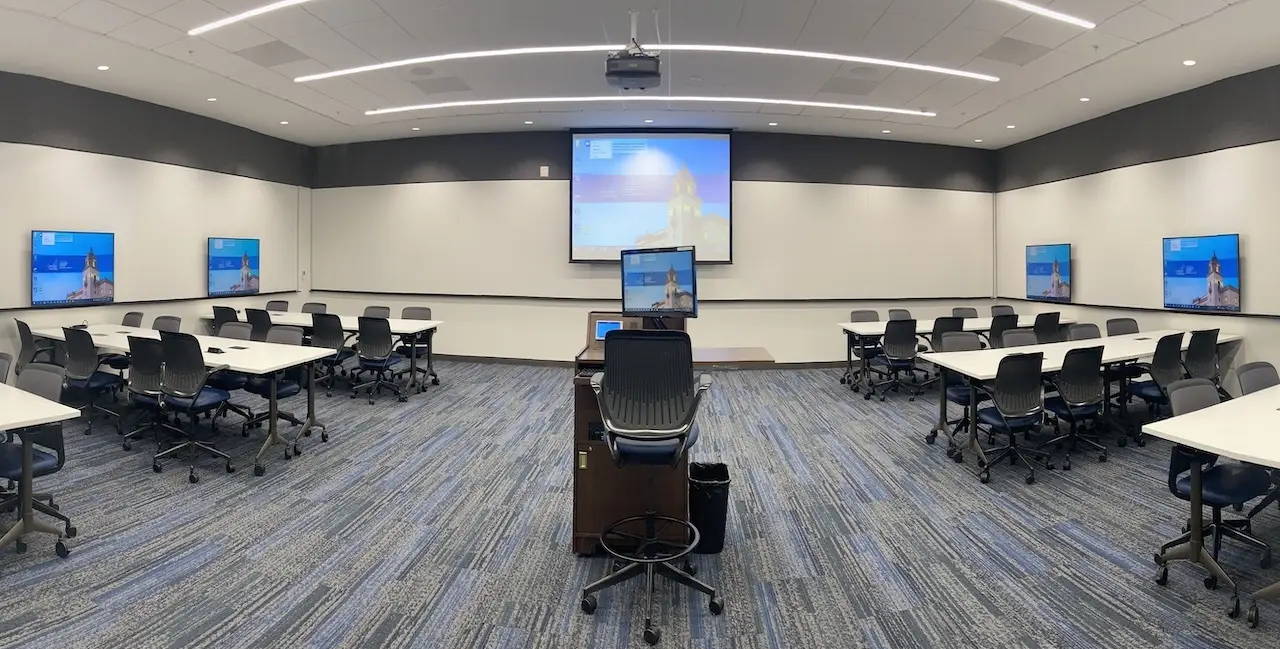Over the last three years, higher education has prioritized hybrid learning, and this trend continues. The pandemic has demonstrated to educational institutions the efficacy and adaptability of hybrid and remote learning methods.
Whether institutions were rushing or took a more deliberate approach to hybrid learning, they are now stepping back to see what worked, asking, what were the levels of student engagement and when did the technology work most effectively? Institutions are now considering the camera experience — considering when they will need a wide shot of an entire room, a close-up of a presenter, or camera tracking. When institutions required to do a quick pivot to hybrid, they did whatever was necessary to get hybrid learning in place, but now realize that they have high value or high visibility spaces and want to create the best experience in those areas while considering the circumstances of instructors and remote and in-person learners.
Futuristic trends
The educational approach of active learning, which involves students in thinking, discussing, investigating, and creating, is making a comeback. Nowadays, it incorporates flipped classrooms & lecture halls, where professors provide recorded content for students to watch independently and then discuss in class. Additionally, there will be a significant growth in Extended Reality Labs (XR Labs) that utilize AR, VR, or a combination of both technologies. In these labs, students use VR goggles to experience different locations, simulations, objects, and more. However, some institutions might not have enough goggles for all students in a class or lab. Nonetheless, most VR goggles allow the video being viewed by the student to be sent back to a PC and distributed to various displays around the room for the entire class to see. Another application of VR technology is when experts can remotely diagnose an issue that a field technician is examining in person.
Learning Labs
More and more, students are getting the opportunity to engage in experiential and gamification learning through simulation labs, teaching kitchens, and other innovative environments. Additionally, eSports Solutions is on the rise and benefits students by teaching them important skills like time management, team building, and collaboration. This approach to learning, which incorporates video game design and elements, has led to a wider use of gamification in education. As a result, it's crucial for instructors to prioritize the user experience when designing these learning spaces. While automation has made systems more sophisticated, it has also made them more complex, and instructors may not have the time to undergo all the necessary training. Ideally, instructors should be able to enter a space, scan their RFID card, and access previously set configurations or preferences. This would eliminate many training requirements and save time for both faculty and technicians.
Faculty can be at ease with automation when it's properly implemented, as it can significantly enhance the learning experience for students. For example, imagine having a fully automated teaching kitchen or lab equipped with cameras and displays that can provide real-time feedback to students. However, it's important to note that simply implementing automation is not enough. The instructor must also be able to operate it efficiently and supervise students effectively. In such a scenario, the instructor would have to constantly move around the room, which can be time-consuming and ineffective. Otherwise the Automation & Control systems becomes futile, and the invested resources would be wasted. Automation & Control systems becomes futile, and the invested resources would be wasted. In such a scenario, the instructor would have to constantly move around the room, which can be time-consuming and ineffective. Therefore, proper training and support for faculty is crucial to ensure that automation is used to its full potential.
Before starting the design and room integration, it's essential to consider all the features required to ensure equitable hybrid learning and bring together pedagogy and technology. While changes have occurred over the past few years, they will probably continue to happen. However, with effective solutions, integrating technology and learning won't be an ongoing challenge.
Creation Networks can help your organization implement AV Technolgy solutions, Crestron control and LED videowall technology for your organization. Across California and nationwide, we design, install, and program state-of-the-art AV systems. Contact Us Today
SUBSCRIBE TO OUR NEWSLETTER
Recieve our latest weekly releases, offers, guides and more.







